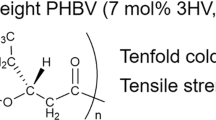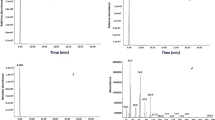Abstract
Azohydromonas lata DSM 1122 was utilized to synthesize short-chain-length (scl-) polyhydroxyalkanoate (PHA) terpolymers containing 3-hydroxybutyric (3HB) acid, 3-hydroxyvaleric (3HV) acid, and 4-hydroxyvaleric (4HV) acid from mixtures of glucose (GLC; 1 wt%) and levulinic acid (LevA; 0–0.4 wt%). LevA media concentrations greater than 0.4% completely inhibited cellular growth. At LevA concentrations ≤ 0.4%, the 3HV polymer content remained constant (3–5 mol%). The 4HV content was two-fold higher in the polymers derived from the 0.2% LevA-containing cultures reaching a maximum of 9 mol% (vs. 4 mol% in the 0.4% LevA-containing cultures). Polymer molecular weights (based on number-average molecular weight, Mn) were smallest (Mn = 240,000 g/mol) when synthesized in the presence of 0.2% LevA. At 0.4% LevA and at 1% GLC the average Mn values were 43% and 87% larger than the polymers synthesized in the presence of 0.2% LevA, respectively. Mixed-cultures containing A. lata and Burkholderia sacchari DSM 17165, a known poly-3-hydroxybutyrate-block-3-hydroxyvalerate (P3HB-block-3HV) producer, using LevA media concentrations ≤ 0.4% and staggered inoculations resulted in scl-PHA polymer mixtures with improved tensile properties. The results of this study show that LevA can be utilized in combination with simple sugars to produce unique scl-PHA terpolyesters and scl-PHA mixtures with enhanced properties.




Similar content being viewed by others
References
http://www.economist.com/graphic-detail/2018/03/06/only-9-of-the-worlds-plastic-is-recycled. Accessed 6 Sept 2018
Jambeck JR, Geyer R, Wilcox C, Siegler TR, Perryman M, Andrady A, Narayan R, Law KL (2015) Plastic waste input from land into the ocean. Science 347:768–771
https://waste-management-world.com/a/blog-a-taxing-question-for-single-use-plastics-recycling. Accessed 8 Sept 2018
Yoshida S, Hiraga K, Takehana T, Taniguchi I, Yamaji H, Maeda Y, Toyohara K, Miyamoto K, Kimura Y, Oda K (2016) A bacterium that degrades and assimilates poly(ethylene terephthalate). Science 351:1196–1199
Austin HP, Allen MD, Donohoe BS, Rorrer NA, Kearns FL, Silveira RL, Pollard BC, Dominick G, Duman R, El Omari K, Mylhaylyk V, Wagner A, Michener WE, Amore A, Skaf MS, Crowley MF, Thorne AW, Johnson CW, Woodcock HL, McGeehan JE, Beckham GE (2018) Characterization and engineering of a plastic-degrading aromatic polyesterase. Proc Nat Acad Sci USA 115:E4350–E4357
Numata K, Abe H, Iwata T (2009) Biodegradability of poly(hydroxyalkanoate) materials. Materials 2:1104–1126
Madison LL, Huisman GW (1999) Metabolic engineering of poly(3-hydroxyalkanoates): from DNA to plastic. Microbiol Mol Biol Rev 63:21–53
Steinbüchel A, Valentin HE (1995) Diversity of bacterial polyhydroxyalkanoic acids. FEMS Microbiol Lett 128:219–228
Doi Y (1990) Microbial polyesters. VCH Publishers, New York
Kunioka M, Kawaguchi Y, Doi Y (1989) Production of biodegradable copolyesters of 3-hydroxybutyrate and 4-hydroxybutyrate by Alcaligenes eutrophus. Appl Microbiol Biotechnol 30:569–573
Valentin HE, Schönebaum A, Steinbüchel A (1992) Identification of 4-hydroxyvaleric acid as a constituent of biosynthetic polyhydroxyalkanoic acids from bacteria. Appl Microbiol Biotechnol 36:507–514
Gorenflo V, Schmack G, Vogel R, Steinbüchel A (2001) Development of a process for the biotechnological large-scale production of 4-hydroxyvalerate-containing polyesters and characterization of their physical and mechanical properties. Biomacromol 2:45–47
Solaiman DKY, Ashby RD, Hotchkiss AT, Foglia TA (2006) Biosynthesis of medium-chain-length poly(hydroxyalkanoates) from soy molasses. Biotechnol Lett 28:157–162
Koutinas AA, Xu YX, Wang R, Webb C (2007) Polyhydroxybutyrate production from a novel feedstock derived from a wheat-based biorefinery. Enz Microb Technol 40:1035–1104
Xu Y, Wang R-H, Koutinas AA, Webb C (2010) Microbial biodegradable plastic production from a wheat-based biorefining strategy. Proc Biochem 45:153–163
Cesario MT, Raposo RS, de Almeida MCMD, van Keulen F, Ferreira BS, Telo JP, da Fonseca MMR (2014) Production of poly(3-hydroxybutyrate-co-4-hydroxybutyrate) by Burkholderia sacchari using wheat straw hydrolysates and gamma-butyrolactone. Int J Biol Macromol 71:59–67
Ashby RD, Solaiman DKY, Foglia TA (2004) Bacterial poly(hydroxyalkanoate) polymer production from the biodiesel co-product stream. J Polym Environ 12:105–112
Cavalheiro JMBT, de Almeida MCMD, Grandfils C, da Fonseca MMR (2009) Poly(3-hydroxybutyrate production by Cupriavidus necator using waste glycerol. Proc Biochem 44:509–515
Zhu C, Nomura CT, Perrota J, Stipanovic AJ, Nakas JP (2010) Production and characterization of poly-3-hydroxybutyrate from biodiesel-glycerol by Burkholderia cepacia ATCC 17759. Biotechnol Prog 26:424–430
Bozell JJ, Moens L, Elliot DC, Wang Y, Neuenscwander GG, Fitzpatrick SW, Bilski RJ, Jarnefeld JL (2000) Production of levulinic acid and use as a platform chemical for derived products. Res Conserv Recycl 28:227–239
Antonetti C, Licursi D, Fulignati S, Valentini G, Galletti AMR (2016) New frontiers in the catalytic synthesis of levulinic acid: sugars to raw and waste biomass as starting feedstock. Catalysts 6:196
Jaremko M, Yu J (2011) The initial metabolic conversion of levulinic acid in Cupriavidus necator. J Biotechnol 155:293–298
Keenan TM, Tanenbaum SW, Stipanovic AJ, Nakas JP (2004) Production and characterization of poly-β-hydroxyalkanoate copolymers from Burkholderia cepacia utilizing xylose and levulinic acid. Biotechnol Prog 20:1697–1704
Koller M, Hesse P, Fasl H, Stelzer F, Braunegg G (2017) Study on the effect of levulinic acid on whey-based biosynthesis of poly(3-hydroxybutyrate-co-3-hydroxyvalerate) by Hydrogenophaga pseudoflava. Appl Food Biotechnol 4:65–78
Rand JM, Pisithkul T, Clark RL, Thiede JM, Mehrer CR, Agnew DE, Campbell CE, Markley AL, Price MN, Ray J, Wetmore KM, Suh Y, Arkin AP, Deutschbauer AM, Amador-Noguez D, Pfleger BF (2017) A metabolic pathway for catabolizing levulinic acid in bacteria. Nat Microbiol 2:1624–1634
Ashby RD, Solaiman DKY, Nuñez A, Strahan GD, Johnston DB (2018) Burkholderia sacchari DSM 17165: a source of compositionally-tunable block-copolymeric short-chain poly(hydroxyalkanoates) from xylose and levulinic acid. Bioresour Technol 253:333–342
Ashby RD, Solaiman DKY, Foglia TA, Liu C-K (2001) Glucose/lipid mixed substrates as a means of controlling the properties of medium chain length poly(hydroxyalkanoates). Biomacromol 2:211–216
Ashby RD, Solaiman DKY, Strahan GD, Zhu C, Tappel RC, Nomura CT (2012) Glycerine and levulinic acid: renewable co-substrates for the fermentative synthesis of short-chain poly(hydroxyalkanoate) biopolymers. Bioresour Technol 118:272–280
Park J-H, Kim S-H, Park H-D, Lim DJ, Yoon J-J (2013) Feasibility of anaerobic digestion from bioethanol fermentation residue. Bioresour Technol 141:177–183
Habe H, Sato S. Morita T, Fukuoka T, Kirimura K, Kitamoto D (2015) Isolation and characterization of bacterial strains with the ability to utilize high concentrations of levulinic acid, a platform chemical from inedible biomass. Biosci Biotechnol Biochem 79:1552–1555
Bluhm TL, Hamer GK, Marchessault RH, Fyfe CA, Veregin RP (1986) Isodimorphism in bacterial poly(β-hydroxybutyrate-co-β-hydroxyvalerate). Macromolecules 19:2871–2876
Saito Y, Doi Y (1994) Microbial synthesis and properties of poly(3-hydroxybutyrate-co-4-hydroxybutyrate) in Comamonas acidovorans. Int J Biol Macromol 16:99–104
Ahagon A, Gent AN (1975) Threshold fracture energies for elastomers. J Polym Sci 13:1903–1911
Acknowledgements
The authors gratefully acknowledge Nicole Crocker, Jennifer Thomas, and Nick Latona for their technical assistance throughout the study.
Disclaimer
Mention of trade names or commercial products in this publication is solely for the purpose of providing specific information and does not imply recommendation or endorsement by the U.S. Department of Agriculture (USDA). USDA is an equal opportunity provider and employer.
Author information
Authors and Affiliations
Corresponding author
Rights and permissions
About this article
Cite this article
Ashby, R.D., Solaiman, D.K.Y. & Strahan, G.D. The Use of Azohydromonas lata DSM 1122 to Produce 4-hydroxyvalerate-Containing Polyhydroxyalkanoate Terpolymers, and Unique Polymer Blends from Mixed-Cultures with Burkholderia sacchari DSM 17165. J Polym Environ 27, 198–209 (2019). https://doi.org/10.1007/s10924-018-1332-2
Published:
Issue Date:
DOI: https://doi.org/10.1007/s10924-018-1332-2




